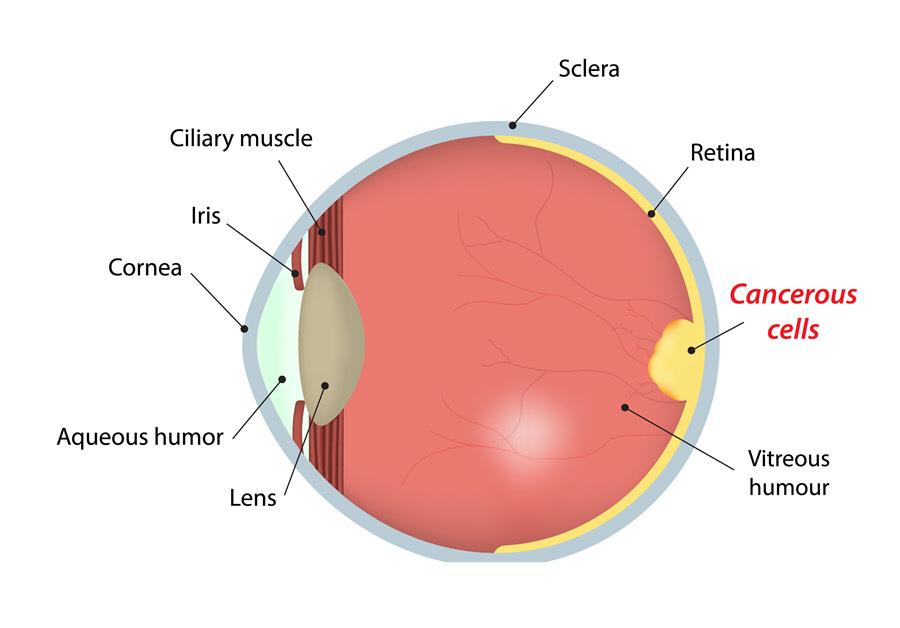Introduction
Eye cancer is a general term that refers to the types of cancer that may develop on or in the eye. Cancer is a malignancy or a group of abnormal cells that grow fast and uncontrollably. They invade and destroy tissues and can move to other parts of the body.
Cancers that occur within the eye are called intraocular cancers. Primary intraocular cancers start in the eye. The most common among adults are ocular melanoma and primary intraocular lymphoma. In children, the most common is Retinoblastoma.
Secondary intraocular cancers or metastatic cancers begin elsewhere and move to the eye. Metastatic cancers are not real eye cancers. Yet, they occur more often than the primary intraocular cancers. Among these, lung and breast cancers are the most common. Often, these cancers invade the uvea, the middle layer of the eyeball.
Melanoma is cancer that grows from melanocytes, the melanin producing cells. Most of these cancers occur in the skin. They can also grow in other areas of the body. Often, when melanoma begins in the eye, it does so in the uvea; uvea melanoma. It rarely occurs in the conjunctiva.
9 out of 10 cases of uvea melanoma develop in the ciliary body or in the choroid layer. Though rare, ocular melanoma is the most common form of cancer that starts inside the eyeball. Most uvea melanomas spread to the liver through the blood.
The other ocular melanomas begin in the iris and grow slowly. Rarely do they expand to other parts of the body.
Retinoblastoma occurs as a result of a genetic mutation. It begins in the retina, spreads to the eye and the rest of the body. It affects children.
Orbital and adnexal cancers start in the tissues surrounding the eyeball such as skin, muscle, tear glands, eyelids and nerve.
Also Known As
Ocular cancer
Sub-Types
- Ocular melanoma
- Retinoblastoma
- Orbital cancer
- Adnexal cancer
- Primary intraocular lymphoma
Causes and Risk Factors
There are no definitive causes of the eye disorder. But, there are certain eye cancer risk factors. People with these characteristics are more prone to develop the disease. Risk factors include:
- Light eye color
- Individuals over 50
- Abnormal moles
- Too much exposure to the sun’s ultraviolet (UV) rays
- Hazardous occupations like farming, fishing, welding, etc.
- Inherited conditions
- Weakened immune system
Signs & Symptoms
Eye cancer can be asymptomatic. The most common sign is painless vision loss.
Other symptoms may include:
- Change in iris color
- Blurred vision in one eye
- Seeing strings or floating objects, floaters
- A dark spot or spots on the iris itself
- Red eye
- Painful eye
- Bulging eye
Diagnosis
The eye professional will conduct a comprehensive eye exam to diagnose eye cancer. It will include a slit lamp exam to check the eye structures and look for abnormalities. The tests may also involve ultrasound scan and fluorescein angiogram. These help to identify location and the size of the cancer, and to get photographs.
A sample of the cancer cells is analyzed in the laboratory. Genetic information of the cancerous cells indicates the nature of the eye cancer. It also shows the probability of spreading or recurring.
Treatment
Treatment is aimed at conserving the affected eye.
Medical Treatment
The size and location of the disorder influences treatment.
Treatment includes:
- Watchful waiting - It’s the close monitoring of asymptomatic patients and those with mild symptoms without giving any treatment.
- Immunotherapy drugs - Researchers have come up with newer drugs to treat advanced melanomas. The drugs encourage the victim’s immune system to identify and destroy cancer cells more effectively.
- Targeted drugs - These are drugs that target the areas of melanoma cells that differentiate them from ordinary cells.
- Chemotherapy drugs - This form of treatment is rarely used to treat eye cancer.
Surgical Treatment
The standard treatments include:
- Surgery - The most common mode of treatment for ocular melanoma.
- Thermotherapy - Uses laser heat to eliminate cancerous cells.
- Photocoagulation - Uses laser light to cut blood supply to the cancerous cells.
- Radiation therapy - Kills or stops cancer cells from multiplying by using powerful x-rays and other forms of radiation.
Alternative Treatment
Prognosis/Long-term outlook
Most patients with iris melanomas have a good outlook.
In the other cases, the prognosis depends on the size of the melanoma and the parts affected.
Overall, eye cancer patients survive for at least five years following diagnosis.
Prevention/Follow Up
The reasons for most eye cancers are not yet understood, so there is little one can do to prevent it.
Regular eye exams can help to detect the disease early.
It is essential to wear sunglasses with ultraviolet (UVA & UVB) protection when outdoors. It protects the eyes and surrounding skin. It might help to lower the risk of skin cancer around the eye and also eye melanoma risk.


